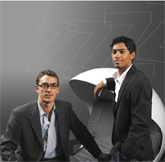
He had an idea. His mind raced with the numerous possibilities that were quickly working their way into a full-fledged business plan: bubble tea.
The tea, created in Taiwan during the early 1980s, is a staple throughout Asia. It combines tea and fruit flavoring or tapioca, which spawn bubbles when mixed. The Asian version of Starbucks was hard to find in Pittsburgh, even though the city is home to a large Asian population that would literally “drink up” the unique beverage.
The opportunity was perfect. Arshad Chowdhury was looking to prove he could be a successful entrepreneur to himself and to his new classmates and professors in Carnegie Mellon’s Tepper School of Business. He started a Pittsburgh bubble tea revolution of sorts during his first semester on campus.
He and 10 other Tepper School students formed The Tea Shop, which sold the specialty tea directly to students and staff at Carnegie Mellon through ‘Tea Shop Parties’ and during University Center movie nights. The success of bubble tea cultivated his entrepreneurial spirit.
He had another idea. Before coming to Carnegie Mellon for his MBA, he had been in investment banking in New York. “I saw a lot of colleagues falling asleep at desks and in meetings—they would even sneak off to the bathrooms to take naps,” he says. He started thinking.
To make sure his hunch was correct, he researched both sleep and workplace trends throughout his last semester at Carnegie Mellon. The data confirmed his suspicions: People were sleeping less and working longer hours.
He believed he had the remedy. So did Tepper’s Donald H. Jones Center for Entrepreneurship, student health services, and student government. They gave him funding to establish a napping center on campus. The center, an enclosed room in the University Center, had an assortment of furniture with varying degrees of comfort because Chowdhury wasn’t sure what would be best for pick-me-up sleep. He also experimented with different levels of light and temperature and provided nappers with different choices of music.
He says his sleep center taught him how to create the most conducive environment for a restful nap during the middle of the day. Given the sleep deprivation among the workforce that his research confirmed, he felt confident that people would be willing to pay to take a nap during the workday.

In 2003, after Chowdhury earned his MBA from Tepper, MetroNaps was formed, and the EnergyPod came into existence.
The EnergyPod is perhaps best described as a comfortable, reclining chair with a light shield that provides exhausted customers with complete quiet (or, if they desire, peaceful music) via Bose headphones. Sleep is ended gently at an allocated time through vibrations and light that gradually fill the pod.
The prototype pod was built by a company that also built the bodies for Formula 1 race cars. “They were accustomed to working with fiberglass and all the curves and styling we had in mind, so it turned out to be a nice fit for the pod,” Chowdhury says.
MetroNaps opened for business on the 22nd floor of the Empire State Building in midtown Manhattan. The plan was to expand with a chain of stores around the country, where people could pay to take naps at retail sites, much like fitness centers. But Chowdhury and his business partner, Christopher Lindholst, who earned his MBA at Columbia University, quickly learned that most people don’t want to travel five or 10 blocks to take a nap—they want to walk five or 10 steps. So their business plan changed; they started installing EnergyPods at customer locations, for around $8,000 per pod.
St. Paul’s Hospital in Vancouver made one of the first purchases. Administrators there told Chowdhury that the EnergyPod has made a “radical difference.” He says they were thrilled that, for the first time, doctors, nurses, and other healthcare professionals actually had a place to rest. Not long after the installation in Vancouver, MetroNaps received calls from no fewer than a dozen hospitals, which now make up more than half the firm’s accounts (an EnergyPod also can be found on campus on the first floor of the Hunt Library).
Chowdhury works directly with all clients. “I am involved in the entire process, from working on customers’ orders to making sure it all fits together properly at the customer’s location. We’re a very small company. We have 20 employees worldwide. At this stage, I like to be there for most of the installations because not many people know how to put the parts together,” he says, adding that his father told him long ago that no job is beneath him, and he took that to heart.
That hands-on sentiment is something he remembers, too, while he and his Tepper classmates moonlighted with The Tea Shop. After study sessions, his apartment became a bubble tea factory where they would put together the tea packets for retailers. “[My classmates] weren’t simply ‘idea people,’” he says.
Neither is Chowdhury. “Our philosophy is that every step of the business, every person in the business, should be able to sell the business. You have to believe in the product. For that reason, you can get fired from MetroNaps if you don’t take a daily nap. You really have to drink the Kool-Aid,” he says.



